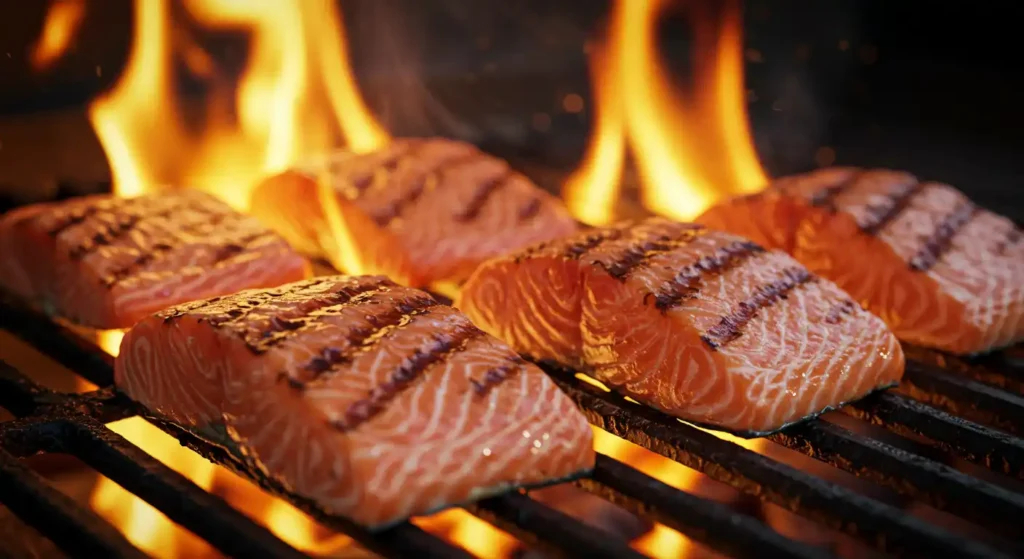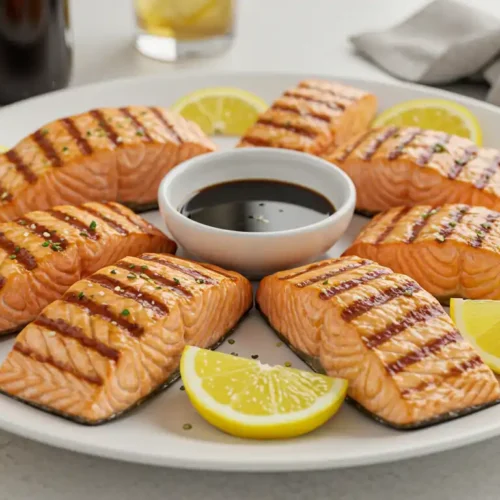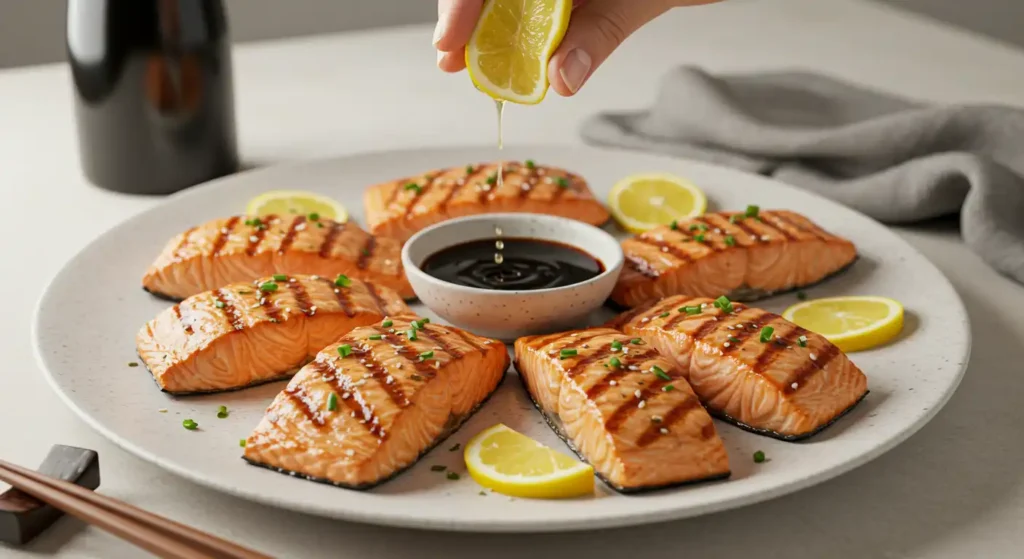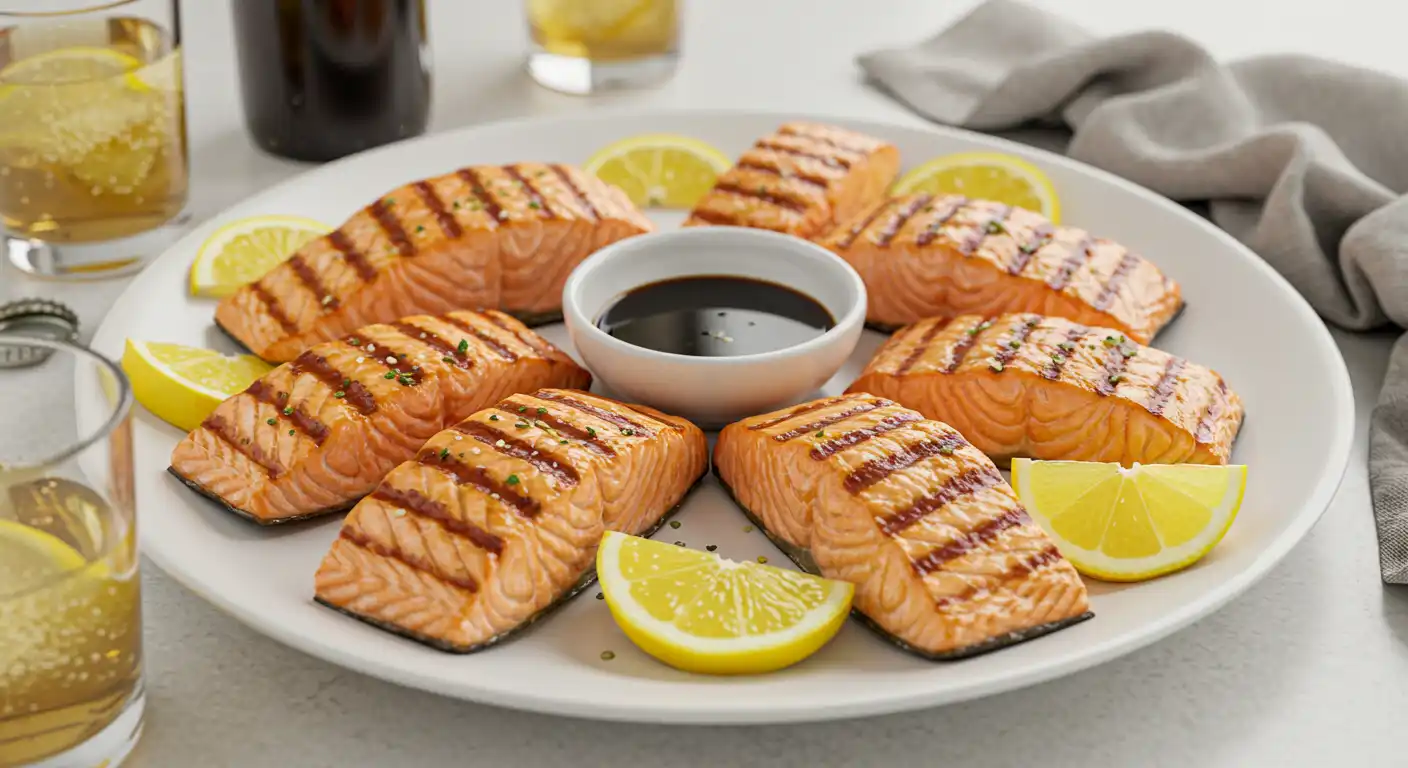Salmon Kama, also known as the salmon collar, is a prized cut from the area between the fish’s head and body, celebrated for its rich flavor and tender texture. This Japanese seafood dish is often revered as a Japanese cuisine delicacy, offering a buttery, melt-in-your-mouth experience. Renowned for its versatility, the best way to enjoy salmon kama is often through simple methods like grilling or broiling, which enhance its natural succulence. Packed with healthy fats and omega-3s, the nutritional benefits of salmon kama are substantial. For those exploring fish collar preparation, mastering a salmon kama recipe reveals just how to cook salmon kama to perfection.
Table of Contents
The Anatomy of Salmon Kama
Understanding the Cut: Where is the Kama Located?
The salmon collar is a tender and flavorful cut located between the head and the belly of the fish. This section is prized for its rich marbling and unique texture, making it a centerpiece of any Japanese seafood dish. Its distinct shape and high-fat content make it ideal for methods like grilled salmon kama. For those exploring fish collar preparation, understanding this cut is crucial for mastering how to cook salmon kama. As a Japanese cuisine delicacy, it offers unmatched taste, and its inclusion in any salmon kama recipe highlights the nutritional benefits of salmon kama beautifully.
Nutritional Benefits:
The nutritional benefits of salmon kama make it an excellent choice for health-conscious seafood lovers. This tender salmon collar is rich in omega-3 fatty acids, which support heart health, brain function, and inflammation reduction. A staple in any Japanese seafood dish, it also contains high-quality protein, essential vitamins, and minerals. Whether enjoyed as grilled salmon kama or incorporated into a creative salmon kama recipe, it offers nourishment with every bite. For those exploring fish collar preparation, this cut provides a nutrient-dense option that complements any meal. Truly, the best way to enjoy salmon kama is by embracing its healthful goodness.
Sustainability and Reducing Waste: The Role of Lesser-Known Cuts
Embracing cuts like Salmon Kama plays a vital role in promoting sustainability and minimizing waste in the seafood industry. The salmon collar, often overlooked, is a flavorful and nutrient-rich part that exemplifies responsible consumption. Including this cut in a Japanese seafood dish reduces the discard of perfectly edible portions, aligning with eco-conscious culinary practices. Learning how to cook salmon kama and exploring a creative salmon kama recipe not only showcases its versatility but also honors the fish fully. By mastering fish collar preparation, you contribute to a sustainable food system while discovering the best way to enjoy salmon kama as a true Japanese cuisine delicacy.
Sourcing Salmon Kama
Where to Find High-Quality Salmon Kama
Finding premium Salmon Kama requires attention to quality and sourcing. Visit specialty seafood markets or Asian grocery stores, where the salmon collar is often available fresh or frozen. For an authentic Japanese seafood dish, ensure the cut is well-marbled and sourced from sustainably caught salmon. Local fishmongers may also stock this Japanese cuisine delicacy, catering to those exploring fish collar preparation. If preparing grilled salmon kama, seek pieces with intact skin and a vibrant color. Online seafood vendors are another excellent option for crafting a unique salmon kama recipe while enjoying the exceptional nutritional benefits of salmon kama.
Tips for Selecting the Best Pieces
Choosing the perfect Salmon Kama involves focusing on freshness and quality. Look for salmon collar pieces with firm, moist flesh and a bright, natural hue. The skin should be intact, free of any dullness or dryness, ensuring it crisps beautifully when making grilled salmon kama. Opt for sustainably sourced cuts to enhance your Japanese seafood dish with eco-conscious ingredients. For the best way to enjoy salmon kama, select pieces with a balanced fat-to-meat ratio, as this enhances both flavor and texture. Whether experimenting with a new salmon kama recipe or perfecting fish collar preparation, premium cuts deliver both taste and the nutritional benefits of salmon kama.
Fresh vs. Frozen: What to Consider
When deciding between fresh and frozen, the choice impacts both flavor and texture. Fresh cuts, especially from the salmon collar, offer a delicate taste and are ideal for dishes like grilled salmon kama. However, frozen can still deliver a high-quality experience, provided it’s properly thawed. If opting for Japanese seafood dish perfection, ensure that the frozen variety has been flash-frozen at peak freshness to retain its taste. Whether preparing a salmon kama recipe or mastering fish collar preparation, both options offer a satisfying experience. Ultimately, both fresh and frozen cuts provide the nutritional benefits of salmon kama, ensuring a flavorful meal.
Preparing Salmon Kama
Essential Tools and Ingredients for Cooking
A few essential tools and ingredients are necessary To cook this Salmon to perfection. A sharp filleting knife is crucial for precise fish collar preparation. For grilled salmon kama, a good-quality grill or grill pan ensures an even sear, while tongs help handle the delicate cut. For seasoning, soy sauce, miso, and mirin are staples in a classic Japanese seafood dish. To enhance flavor, fresh herbs like green onions and ginger complement the richness of the salmon collar. Whether following a traditional salmon kama recipe or experimenting with new methods, these ingredients ensure you achieve the best way to enjoy salmon kama while unlocking the nutritional benefits of salmon kama.
Cleaning and Prepping the Kama for Cooking
Cleaning and prepping this Salmon is a crucial step in ensuring optimal flavor and texture. Begin by gently rinsing the salmon collar under cold water, removing any scales or residual bloodline. Pat dry with paper towels to maintain the skin’s crispness, especially if preparing grilled salmon kama. For fish collar preparation, trim away any excess fat, leaving just enough to enhance the flavor. A light soy sauce, garlic, and ginger marinade work wonders to elevate the cut. Mastering how to cook salmon kama starts with these steps, ensuring a delicious outcome for any Japanese seafood dish or salmon kama recipe while preserving the nutritional benefits of salmon kama.
Popular Marinades and Seasonings to Enhance Flavor
To enhance the flavor the right marinades and seasonings make all the difference. A classic choice for a Japanese seafood dish involves a blend of soy sauce, mirin, and a touch of sake, which infuses the salmon collar with rich umami. For those seeking a bolder taste, consider using a mix of garlic, ginger, and sesame oil, which complements the fish’s natural oils. When grilling a brush of teriyaki sauce can add a caramelized finish. Perfecting fish collar preparation with these flavors is one of the best ways to enjoy salmon kama, unlocking both its taste and nutritional benefits of salmon kama.
Cooking Techniques:
Grilling: Achieving the Perfect Char
Grilling Salmon Kama is the ideal way to achieve a crispy, smoky char while retaining its tender interior. For perfect grilled salmon kama, preheat the grill and ensure the salmon collar is well-oiled to prevent sticking. A high heat sears the outside, locking in moisture and flavor. How to cook salmon kama on the grill requires attention to timing—flip it gently once the skin crisps. This method is arguably the best way to enjoy salmon kama, creating a memorable Japanese seafood dish with rich, smoky notes. Plus, it preserves the nutritional benefits of salmon kama.

Broiling: A Quick and Flavorful Option
Broiling Salmon Kama is a quick and effective way to achieve a perfectly cooked, flavorful result. Place the salmon collar under a preheated broiler, allowing the high heat to crisp the skin while keeping the fish tender. For those learning how to cook salmon kama, broiling is a simple, efficient method. This technique is ideal for creating a delicious Japanese seafood dish, retaining the nutritional benefits of salmon kama while enhancing its natural flavors. It’s a great alternative to grilled salmon kama, offering a fast, savory option for the best way to enjoy salmon kama.
Baking: Low-Maintenance and Consistently Delicious
Baking this kind of Salmon offers a low-maintenance yet consistently delicious result. Simply season the salmon collar and place it in the oven to cook slowly, preserving its natural moisture and flavor. For those unsure of how to cook salmon kama, this method guarantees even heat distribution, perfect for creating a juicy, tender piece of fish. A baked Japanese seafood dish also locks in the nutritional benefits of this kind of Salmon, ensuring a satisfying and healthy meal. It’s an effortless way to enjoy the best way to enjoy while savoring its delicate taste.
Pan-Frying: Crisping to Perfection
Pan-frying Salmon Kama is a fantastic way to achieve a crisp, golden crust while retaining the fish’s rich flavor. Begin by heating a generous amount of oil in a pan, then add the salmon collar, cooking until the skin crisps up. This method is perfect for a quick Japanese seafood dish with a satisfying crunch. For those learning how to cook salmon kama, pan-frying offers an easy approach. The result is a delicious, flavorful salmon kama recipe, preserving the nutritional benefits of salmon kama and delivering the best way to enjoy salmon kama.

Easy Salmon Kama Recipe
Equipment
- Grill or broiler
- Baking sheet (for broiling)
- Small bowl (for marinade)
- Tongs
Ingredients
- 2–4 pieces of salmon kama
- 2 tbsp soy sauce
- 1 tbsp sake
- 1 tsp grated ginger
- Sea salt and lime wedges optional
Instructions
- Rinse the salmon kama under cold water and pat dry.
- In a small bowl, combine soy sauce, mirin, sake, and grated ginger to prepare the marinade.
- Marinate the salmon kama for 30 minutes to let the flavors develop.
- Preheat your grill or broiler to high heat.
- Grill or broil the salmon kama for 6–8 minutes per side, until the edges are crispy and the meat is tender.
- Serve immediately with rice, miso soup, and a garnish of lime wedges for extra freshness.
Notes
- For a more authentic flavor, try grilling over charcoal.
- This recipe can be adapted to pan-frying or baking if a grill or broiler isn’t available.
- Serve with steamed rice and miso soup for a complete Japanese meal.
Serving and Pairing Salmon Kama
Simple Plating Ideas for a Stunning Presentation
For a stunning presentation, begin by placing the Salmon Kama at the center of the plate, showcasing its vibrant color and crispy edges. For grilled salmon kama, a drizzle of soy glaze can add both visual appeal and flavor. Surround the salmon collar with a delicate garnish of microgreens or pickled vegetables, enhancing the plate’s aesthetic. For an elegant touch, a smear of wasabi or miso paste can elevate the Japanese seafood dish. Consider using minimalist plating techniques to let the dish shine. These small touches will ensure the best way to enjoy salmon kama is also a feast for the eyes while preserving the nutritional benefits of salmon kama.
Perfect Side Dishes to Complement the Richness of Salmon Kama
To balance the richness of Salmon Kama, serve it with light, refreshing side dishes. A citrusy salad with a miso dressing perfectly complements the salmon collar, cutting through its natural oils. For a more traditional approach, consider pairing it with Japanese seafood dish staples like steamed rice and pickled vegetables. How to cook salmon kama can also be enhanced with a side of sautéed spinach or delicately steamed asparagus. These sides not only elevate the salmon kama recipe but also bring out the nutritional benefits of salmon kama, ensuring a well-rounded and satisfying meal. The best way to enjoy salmon kama is with sides that highlight its delicate flavor.
Beverage Pairings: Wine, Sake, and Non-Alcoholic Options
Pairing beverages with this kind of Salmon enhances the overall dining experience. For a refined touch, a crisp white wine like Sauvignon Blanc complements the rich flavors of grilled salmon kama. If opting for an authentic pairing, sake offers a smooth, slightly sweet contrast to the savory depth of salmon collar. For non-alcoholic options, try a green tea or a lightly flavored ginger soda, both of which match the Japanese seafood dish perfectly. Whether you choose wine, sake, or a non-alcoholic drink, selecting the right beverage is the best way to enjoy this kind of Salmon, bringing out its natural flavors and nutritional benefits.
Exploring Global Takes on Salmon Kama
Japanese Traditions: Shioyaki and Beyond
In Japanese cuisine delicacy, one of the most beloved methods of preparing fish, including Salmon Kama, is shioyaki—a traditional technique where fish is seasoned with salt and grilled to perfection. This simple yet effective preparation enhances the natural flavors of the salmon collar, resulting in a tender and crispy texture. While grilled salmon kama is often the highlight, shioyaki can be applied to various fish, showcasing Japan’s mastery in elevating the nutritional benefits of salmon kama. Understanding how to cook salmon kama through this method offers a glimpse into the essence of Japanese culinary traditions and the best way to enjoy salmon kama.
Western Twists on Salmon Kama Recipes
Western chefs have embraced Salmon Kama, adding creative twists to the traditional Japanese seafood dish. For instance, grilled salmon kama can be paired with herb-infused butter or citrus-based glazes to add a zesty, rich contrast. Salmon collar is often roasted with garlic, rosemary, and balsamic reduction, elevating the dish beyond classic fish collar preparation. By exploring a Salmon kama recipe that combines Western ingredients, you enhance the nutritional benefits of salmon kama while still appreciating its natural flavors. The best way to enjoy salmon kama in these fusion dishes is with a balance of bold, fresh flavors that complement its delicate richness.

Fusion Flavors: Experimenting with Bold Seasonings
Fusion flavors provide a unique opportunity to reimagine Salmon Kama, blending diverse seasonings for an exciting twist. Instead of traditional marinades, try infusing the salmon collar with smoky paprika, spicy harissa, or even tangy tamarind, creating a vibrant contrast to the natural richness. Grilled salmon kama can be elevated with bold combinations like a miso-honey glaze or wasabi-lime aioli, offering a modern take on a Japanese cuisine delicacy. Experimenting with these flavors in your Salmon kama recipe not only enhances the taste but also maximizes the nutritional benefits of salmon kama, making it an irresistible, healthy choice.
Why You Should Embrace Salmon Kama
Affordability Meets Gourmet Appeal
Salmon Kama offers an affordable yet gourmet dining experience, making it an excellent option for both home cooks and restaurant menus. The salmon collar, often overlooked, boasts rich flavors and a tender texture that rivals premium cuts, all at a fraction of the price. When grilled salmon kama is prepared with the right seasonings, it transforms into a stunning Japanese seafood dish. The best way to enjoy salmon kama is often through simple yet flavorful fish collar preparation that highlights its natural essence. Embrace this Japanese cuisine delicacy and explore the nutritional benefits of salmon kama without breaking the bank.
A Unique Addition to Your Culinary Repertoire
Incorporating Salmon Kama into your culinary repertoire introduces a unique and flavorful dimension. The salmon collar is an often overlooked part of the fish, but when grilled salmon kama is prepared properly, it becomes a delectable Japanese seafood dish. Learning how to cook salmon kama with a few simple techniques will open up a world of culinary possibilities. Whether using a simple salmon kama recipe or experimenting with fish collar preparation, it offers a delightful way to savor this Japanese cuisine delicacy. Plus, the nutritional benefits of this kind of Salmon make it an exceptional choice for health-conscious food enthusiasts.
Sharing the Joy: Introducing Friends and Family to Salmon Kama
Introducing friends and family to Salmon Kama can be a delightful culinary adventure. The rich, flavorful salmon collar offers a unique texture and taste, making it an excellent choice for a memorable gathering. Serve grilled salmon kama with a variety of sides to highlight its savory appeal. Share your knowledge of how to cook salmon kama, or follow a simple salmon recipe for a hassle-free experience. This Japanese seafood dish is not only a conversation starter but also a Japanese cuisine delicacy. Enjoy the nutritional benefits of salmon, making it a wholesome and delicious meal to share.
Frequently Asked Questions (FAQs)
What exactly is salmon kama?
Salmon kama refers to the collar of the fish, the triangular section located just behind the gills and below the head. This cut is prized in Japanese cuisine for its high-fat content and rich flavor, offering a tender, melt-in-your-mouth texture. It is considered a delicacy and is often prepared using simple cooking techniques like grilling or broiling.
Which part of the fish does kama come from?
The kama, or collar, is the part of the fish near the head and behind the gills. It is a small, fatty cut that includes the area around the pectoral fins and the bones. This section is known for its succulent, flavorful meat.
Are salmon collars a good choice?
Salmon collars are an excellent choice for their rich taste, affordability, and nutritional benefits. They are high in Omega-3 fatty acids and proteins, making them both delicious and healthy. Their versatility in cooking also makes them a favorite among seafood lovers.
Is Hamachi Kama a healthy option?
Yes, Hamachi Kama is a healthy option, similar to salmon kama, as it is rich in Omega-3 fatty acids, protein, and essential nutrients. This cut is particularly appreciated for its tender meat and high-fat content, which contributes to its deep flavor. It’s an excellent choice for those seeking a nutritious and flavorful seafood dish.
How does a Hamachi collar taste?
A Hamachi collar is known for its rich, buttery taste with a mild sweetness, complemented by a delicate, flaky texture. Its high-fat content near the bone enhances the flavor, making it tender and juicy when grilled or broiled. This taste is often compared to premium cuts of fish but with an even more satisfying depth.
From Hidden Gem to Your Next Favorite Dish
Salmon kama is more than just a “leftover” cut—it’s a flavorful, affordable, and nutrient-packed addition to any home cook’s repertoire. Whether you’re a seasoned fan of Japanese seafood cuisine or just now venturing into the world of fish collars, this dish is bound to leave an impression.
Pick up some salmon kama at your local fish market or try our easy salmon recipe today. Don’t forget to share your culinary creations online—tag us and show off your dishes!

